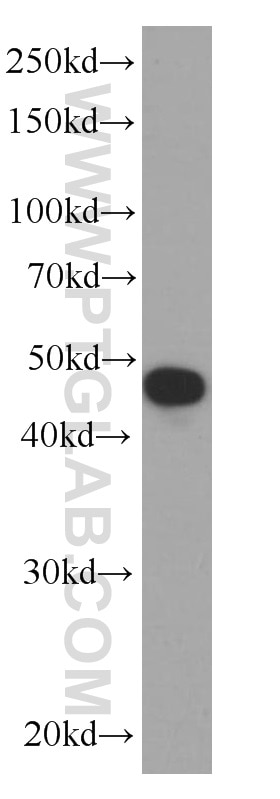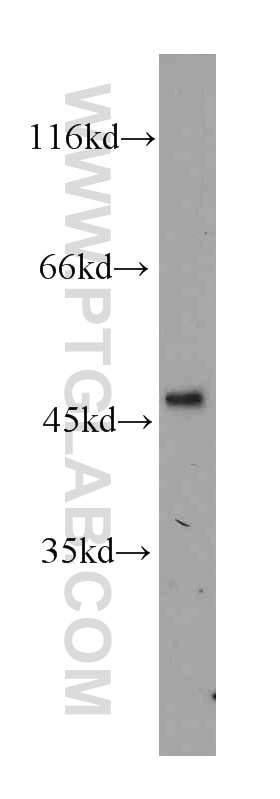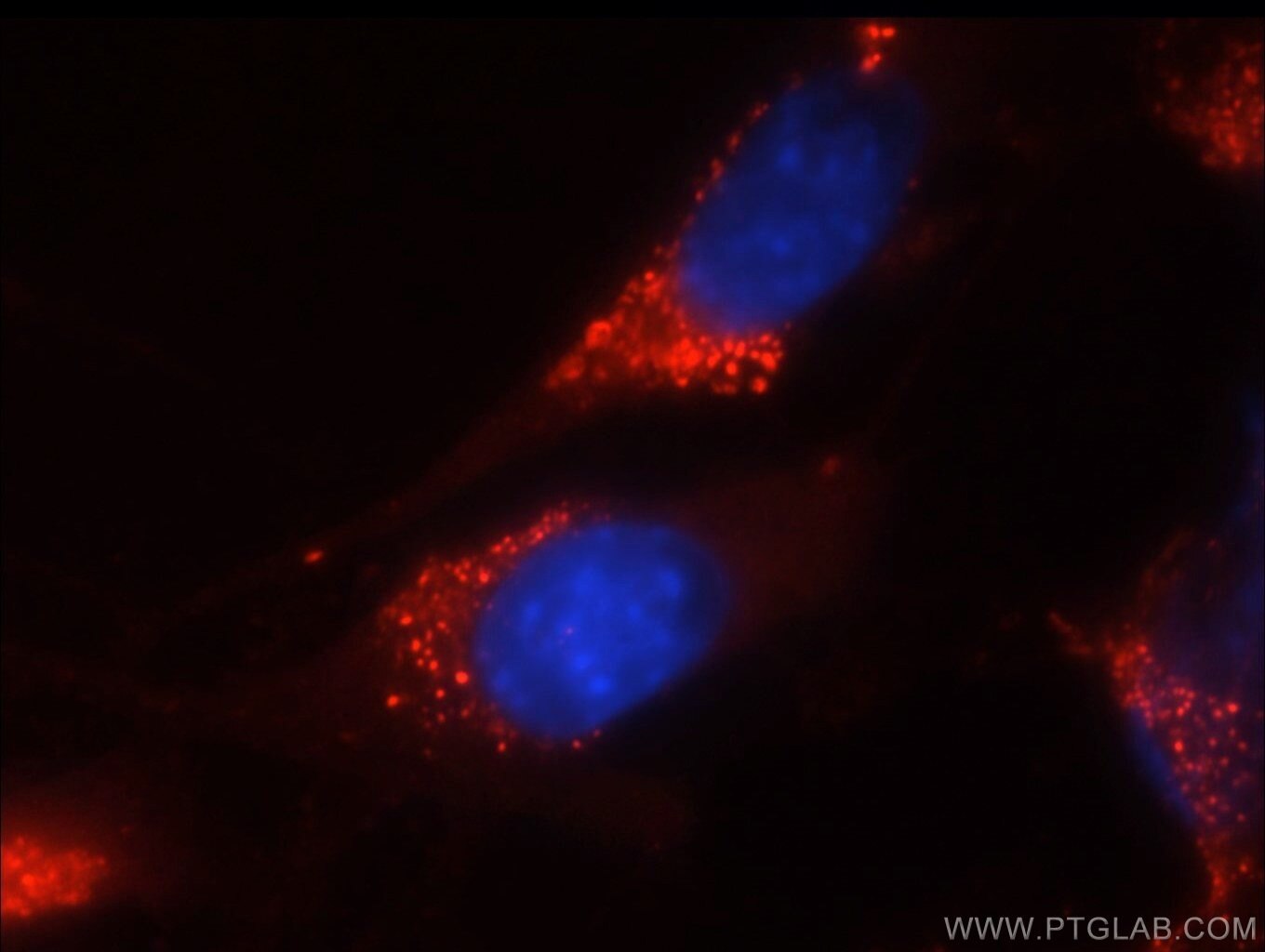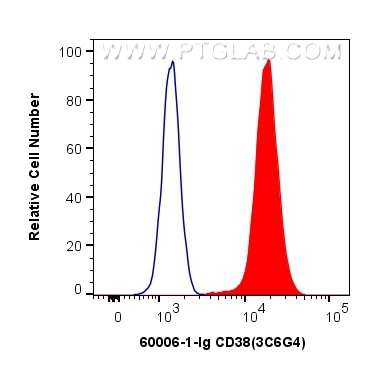- Phare
- Validé par KD/KO
Anticorps Monoclonal anti-CD38
CD38 Monoclonal Antibody for FC, IF, WB, ELISA
Hôte / Isotype
Mouse / IgG1
Réactivité testée
Humain, souris
Applications
WB, IF, FC, ELISA
Conjugaison
Non conjugué
CloneNo.
3C6G4
N° de cat : 60006-1-Ig
Synonymes
Galerie de données de validation
Applications testées
| Résultats positifs en WB | cellules Jurkat, cellules Raji |
| Résultats positifs en IF | cellules NIH/3T3 |
| Résultats positifs en cytométrie | cellules Daudi, |
Dilution recommandée
| Application | Dilution |
|---|---|
| Western Blot (WB) | WB : 1:500-1:2000 |
| Immunofluorescence (IF) | IF : 1:10-1:100 |
| Flow Cytometry (FC) | FC : 0.40 ug per 10^6 cells in a 100 µl suspension |
| It is recommended that this reagent should be titrated in each testing system to obtain optimal results. | |
| Sample-dependent, check data in validation data gallery | |
Applications publiées
| KD/KO | See 2 publications below |
| WB | See 3 publications below |
| IF | See 2 publications below |
Informations sur le produit
60006-1-Ig cible CD38 dans les applications de WB, IF, FC, ELISA et montre une réactivité avec des échantillons Humain, souris
| Réactivité | Humain, souris |
| Réactivité citée | Humain, souris |
| Hôte / Isotype | Mouse / IgG1 |
| Clonalité | Monoclonal |
| Type | Anticorps |
| Immunogène | CD38 Protéine recombinante Ag0487 |
| Nom complet | CD38 molecule |
| Masse moléculaire calculée | 300 aa, 34 kDa |
| Poids moléculaire observé | 45 kDa |
| Numéro d’acquisition GenBank | BC007964 |
| Symbole du gène | CD38 |
| Identification du gène (NCBI) | 952 |
| Conjugaison | Non conjugué |
| Forme | Liquide |
| Méthode de purification | Purification par protéine A |
| Tampon de stockage | PBS avec azoture de sodium à 0,02 % et glycérol à 50 % pH 7,3 |
| Conditions de stockage | Stocker à -20°C. Stable pendant un an après l'expédition. L'aliquotage n'est pas nécessaire pour le stockage à -20oC Les 20ul contiennent 0,1% de BSA. |
Informations générales
CD38, also known as ADP-ribosyl cyclase 1, is a type II transmembrane glycoprotein with a short N-terminal cytoplasmic tail, a single membrane-spanning domain, and a C-terminal extracellular region with four N-glycosylation sites (PMID: 2319135). The extracellular domain of CD38 has bifunctional enzyme activities that catalyze synthesis of cyclic ADP ribose from nicotinamide adenine dinucleotide (NAD) and hydrolysis of cyclic ADP ribose to adenosine diphosphoribose (PMID: 10636863). CD38 is expressed on a variety of hematopoietic and non-hematopoietic cells and is involved in diverse processes such as generation of calcium-mobilizing metabolites, cell activation, and chemotaxis (PMID: 25938500).
Protocole
| Product Specific Protocols | |
|---|---|
| WB protocol for CD38 antibody 60006-1-Ig | Download protocol |
| IF protocol for CD38 antibody 60006-1-Ig | Download protocol |
| Standard Protocols | |
|---|---|
| Click here to view our Standard Protocols |
Publications
| Species | Application | Title |
|---|---|---|
Nat Immunol PD-1 blockade in subprimed CD8 cells induces dysfunctional PD-1+CD38hi cells and anti-PD-1 resistance.
| ||
Glia Activation of astrocytic sigma-1 receptor exerts antidepressant-like effect via facilitating CD38-driven mitochondria transfer.
| ||
Cancer Cell Int Targeting Lymphotoxin Beta and Paired Box 5: a potential therapeutic strategy for soft tissue sarcoma metastasis. | ||
Cell Rep Longitudinal analyses reveal distinct immune response landscapes in lung and intestinal tissues from SARS-CoV-2-infected rhesus macaques. | ||
J Immunol Polarization and β-Glucan Reprogram Immunomodulatory Metabolism in Human Macrophages and Ex Vivo in Human Lung Cancer Tissues | ||
J Nutr Biochem Both prolonged high-fat diet consumption and calorie restriction boost hepatic NAD+ metabolism in mice |
Avis
The reviews below have been submitted by verified Proteintech customers who received an incentive forproviding their feedback.
FH Komuraiah (Verified Customer) (07-16-2021) | CD38 expression that I tested in kidney tissue from control and cisplatin induced kidney injury model. This antibody is working great with high specificity with suggested molecular size.
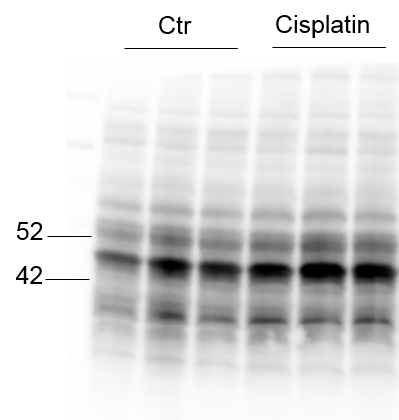 |
